Volvo V50 and small Volvos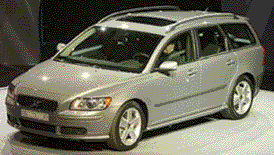
A Brief History of Small VolvosThe Volvo BV plant came into Volvo ownership when the company acquired a 75% stake in D The Volvo 480ES, introduced in 1986, was a front-drive hatchback which was conceptually rather similar to the P1800 ES. The 480 used a 1.7 Renault engine, and was built in the Netherlands at the Volvo BV plant. In 1988 Volvo introduced the Volvo 440 - an important new model in the intermediate class and developed by Volvo Car B.V. in Holland. Its roadholding and safety in particular were acclaimed by the press, as was the generous amount of space inside the car. In 1995 Volvo unveiled a completely new vehicle family while stepping up development efforts on new products. The compact Volvo S40/V40 - the first cars to emerge from the joint venture with Mitsubishi - were presented during the year. The Volvo S40, a four-door sedan, was shown for the first time at the Frankfurt Show in September, while the Volvo V40, a versatile and practical five-door touring car, was put on display in Bologna towards the end of the year. The Mitsubishi Carisma had already been unveiled earlier in the year. Volvo and Mitsubishi were now building completely different car models at the Born Plant, using the same production equipment. With softer, more sweeping lines, the front-wheel drive Volvo S40/V40 represented a departure from the styling of Volvo models in recent years. They were available with a choice of three engines: two four-cylinder petrol engines of 2.0 and 1.8 liters and a turbocharged 1.9-liter diesel. These two cars set a completely new standard of safety in the compact class - pioneering side-impact airbags as standard equipment, for instance. In order to release capacity at the Born Plant, production of the Volvo 480 was discontinued. The biggest shock was a Volvo with curves. The S/V40 range was the result of a joint venture with Mitsubishi. The styling of the car was much more up to date than its predecessor, the 440. In fact, the V40 wagon was named most beautiful estate car by an Italian magazine. In 1996 production of the Volvo S40 and V40 got fully under way and the car was soon very popular in Italy, Germany and the UK, among other places. In November, the last car in the Volvo 400 Series was manufactured, after production of almost 700,000 units since 1985. The first small Volvos were introduced to the North America market were the S40 and V40 in 2000. The S40 sedan and V40 wagon are appearing on the US market after 4 years on the European market. These cars were co-developed with Mitsubishi in the Netherlands. These vehicles are built in the Netherlands and feature a 160-horsepower 1.9-liter four-cylinder turbocharged engine. These are the smallest Volvos, between the size of a Toyota Corolla and Nissan Altima. Volvo's previous S40 continues to be built at Born, Holland until spring 2004, and its demise after that signals the end of Volvo's Dutch connection which began with DAF. The new S40 and its forthcoming V50 estate version, which share nothing at all with their predecessors, are to be built in Ghent, Belgium. The new S40 is based on Ford's C1 platform, derived from the current Focus, which also underpins the next Focus, the Focus C-MAX and the Mazda 3. Volvo calls it P1 (for Premium). The main point of interest is the S40's interior and its 'floating' center console, inspired variously by a famous bent-wood chair by Arne Jacobsen, by Palm Pilots and by Bang & Olufsen remote controls. Thin, like a flat-screen TV, the console has nothing but empty space behind it and a so-called IDIS (Intelligent Driver Information System) within it. The top model is the T5, which is less muscular than some other Volvo T5s with 220bhp from its 2.5-liter engine. This, a 170bhp 2.4-litre naturally-aspirated five-pot and a 2.0-liter turbo-diesel four, will all be offered from the February UK on-sale date. A 1.8 gas engine follows soon after, and two 1.6s - one gas, one diesel - complete the range at the end of 2004. There will also be some bi-fuel engines. The all new Volvo V50 replaces the current V40, which was launched in the United States in 1999. It is bigger than the S40 but smaller than the S60. Sales of the all new V50 sportswagon will begin in the U.S. in summer, 2004 as a 2005 model. Volvo Introduces the V50
The V50 Sportswagon will be produced alongside the S60 and All-New S40 at Volvo's plant in Ghent, Belgium. Volvo's production operations in Born in the Netherlands will cease with the phasing out of the previous Volvo S40 and V40 models. The Ghent Plant, when fully extended, will be the company's largest production unit with an annual capacity of 270,000 cars. First deliveries to UK showrooms expected late March or early April. Volvo plans to sell 74,000 V50 Sportswagons a year globally, including 8,000 in the UK. Volvo Cars of North America expects to sell 6,500 units annually in the U.S. The all new V50 is the second in a range of new Volvo models sharing common technology with Ford and Mazda. Prices for the UK version of the V50 Sportswagon are expected to start from less than £17,500. What Is New?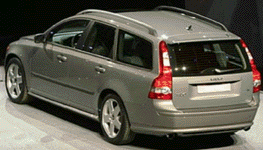
A significant wheelbase stretch and a wider front and rear track give the wheels the "pushed to the corners" look, while increasing the car's appetite for enthusiastic driving around twists and turns. Said wheels can be up to 18 inches in diameter (and matched with low-profile performance tires), depending on the buyer's wishes. The standard suspension is designed to balance comfort and sport, according to Volvo, but more serious drivers can equip the wagon with a sport suspension that specifies firmer springs and a lowered stance. The steering uses an electro-hydraulic setup. Engine choices are identical to those of the S40 sedan introduced at fall 2003 Frankfurt International Motor Show. The base motor is a naturally aspirated 2.4-liter inline five-cylinder that produces a respectable 168 horsepower. Those looking for more juice underfoot can go with a turbocharged 2.5-liter inline five that puts out 218 horsepower. Both engines make use of continuously variable valve timing to maximize power and efficiency. If you live in a snowy climate, you can opt for an electronically controlled all-wheel-drive system with the bigger engine. Inside, Volvo wanted the V50 to have a spacious, contemporary feel with user-friendly ergonomics and plenty of storage areas for passengers' belongings. Legible instrumentation and a space-saving center stack support that objective, as does subtle "theater-style" lighting that follows the driver's hands toward various controls to simplify nighttime adjustments. Both the front-passenger seat and the 60/40-split rear seats fold flat, yielding a continuous load floor for all manner of oddly sized cargo. Along with a carefully designed structure (that provides for optimal deformation according to crash severity), the V50 includes a full complement of side-impact and head curtain airbags. Among the available options are a Dolby Surround Pro Logic stereo with a max output of 445 watts and built-in booster seats that make this compact wagon a practical choice for hauling around the kids. AWD V50 Features Haldex AWD System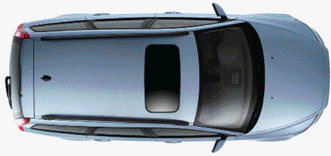
The AWD variant V50 T5 has the latest generation Haldex AWD system, whose software is an integral part of the technology creating the vehicle dynamics which give the wanted youthful and modern sports-wagon characteristics. Even though the AWD system is customized for V50 T5, the system shares most of the technology with other AWD systems from Haldex on other Volvo models. "The T5 engine and AWD give the V50 model extremely enjoyable road manners", says Peter Ewerstrand, the project leader for the V50 and S40 programs, in a press release from Volvo. "Top class performance is combined with responsive, stable driving characteristics." The new Volvo V50 will start selling in the first half of 2004. The AWD variant will, however, not be available at start but will be introduced later in the year. The V50 T5 with Haldex AWD system complements the existing series of four-wheel-drive cars from Volvo - all with Haldex AWD system. Among those are the successful SUV XC90 and the advanced S60/V70 R cars. V50 Design Shows Volvo Roots
From the outside, the all new V50 is unmistakably a Volvo, a modern evolution of the sportswagon design language that began with the V70 family wagon. The all new Volvo V50 is a totally new five-door model with aggressive lines, intelligent design solutions and a flexible interior. "The all new V50 is the result of a consistent design strategy, in which the Volvo character has been developed for each new model," says Henrik Otto, Volvo Cars' Design Director. "Our new sportswagon is indisputably a genuine Volvo but, at the same time, it has its own, totally individual and distinct profile - with characteristics from classics such as the Volvo 1800 ES, Volvo 480 and its most recent predecessor, the V40." The interior is a revolution, with an ultra-slim center console - the first of its kind in the automotive world - creating an aura of exclusivity, simplicity and space. "The center console is a design icon for the all new Volvo V50 and S40 sport sedan," says Otto. "What sets the all new V50 apart is the ability for the car to carry both people and all the important stuff that allows them to live their lives to the fullest. It is truly a car with a large capacity for life!" "With the all new Volvo V50, we now offer our customers the benefits and utility of the V70 in a sporting, exciting design with exceptional road manners. Once again, Volvo is setting the standard in the wagon segment," comments Olsson. Expanding the brand to appeal to a broader age range is an important part of Volvo Cars' strategy - it is particularly important that this new model appeal to young buyers. "We want to attract customers into the Volvo family as early as possible, and the new Volvo V50 will definitely appeal to younger buyers," said Olsson. Safety Is Paramount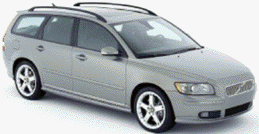
Safety is not the most important thing at Volvo, it´s everything, and this has given Volvo a unique and impressive reputation for safety research and innovation. The V50 Sportswagon is no exception. Extensive crash testing has produced a new, patented front section cleverly and precisely divided into several zones to deliver large car safety levels. Inside the Volvo V50, the ignition key has been moved from the steering column to the dashboard for better knee protection in an accident, while the bodyshell is 54mm wider than the V40 it replaces providing valuable extra space for Volvo´s SIPS (Side Impact Protection System) to absorb any side deformation. Of course, the V50 Sportswagon offers the same interior protection as Volvo´s larger models and shares Volvo´s WHIPS (Whiplash Protection System) and SIPS (Side Impact Protection System) with side inflatable curtains and airbags. Externally, to help reduce the risk of injury if the Volvo V50 is involved in an accident with pedestrians or cyclists, it has an energy absorbing structure ahead of the front bumper, smooth surfaces and rounded corners. In addition, to help reduce the risk of head injuries, there's a generous 70mm of space between the bonnet and the engine. Volvo's Intelligent Vehicle Architecture (VIVA)In the all new Volvo V50, Volvo Cars continues its innovative use of steel. In the new, patented front structure, four different grades of steel are used in an intelligent interplay to provide maximum safety for the car's occupants. "Naturally, our goal is that the all new Volvo V50 should be the safest car in its class," says Volvo Cars President Hans-Olov Olsson. Side impact protection is addressed by the use of extremely rigid cross members that form a three-way attachment between the leading edge of the A-pillar and the base of the B-pillar. Similar cross members are found in the rear doors as well. This system of energy absorption, along with the new slim-design 5-cylinder engines is called Volvo's Intelligent Vehicle Architecture (VIVA), and represents a new approach to vehicle safety design. Further innovation is provided by Volvo's new 'IDIS' - Intelligent Driver Information System - which uses advanced technology to monitor the driver's level of activity and, if maximum concentration is needed (e.g. when braking, turning, etc.), delays any unnecessary signals and potential distractions, such as incoming telephone calls or non-essential information, until it is safer to do so. The V50 has a 78mm longer wheelbase, up to 63mm wider track, and a 34 per cent stiffer bodyshell than the V40 it replaces. For maximum driver confidence, all V50 drivers have the valuable added control and safety of EBA (Emergency Brake Assistance) plus DSTC (Dynamic Stability and Traction Control) as standard. Extensive crash testing has produced a new, patented front section cleverly and precisely divided into several zones to deliver large car safety levels. V50 PerformanceThe new Volvo V50 has a stable, large car feel, with great handling, thanks to having a wheel virtually at every corner and a 78mm longer wheelbase, up to 63mm wider track, and a 34 per cent stiffer bodyshell than the V40 it replaces. For maximum driver confidence, all V50 drivers have the valuable added control and safety of EBA (Emergency Brake Assistance) plus DSTC (Dynamic Stability and Traction Control) as standard. The all new Volvo V50 is being introduced with a choice of innovative 5-cylinder engines: a normally aspirated 2.4-liter unit producing 168-horsepower, and a 2.5-liter 218-horsepower light-pressure turbocharged T5 engine. Those who crave an even more dynamic driving experience may equip their car with electronic Haldex All Wheel Drive. Performance is further accentuated through the available sport accessory kit, which enhances the aggressive lines of the car through specially designed spoilers on the front; sides and rear, along with larger wheels and dual exhaust tips. In the UK there will also be a new, four-cylinder, 136bhp, 2.0 turbo diesel engine producing 320Nm of torque with a six-speed manual gearbox. This will be available with a particulate filter during 2004. Innovative Interior & Exterior Design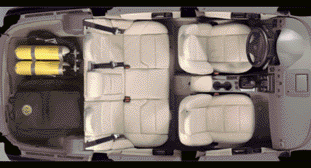
The most distinctive and advanced feature of the Volvo V50 is its trendy interior and dashboard featuring a unique, ultra-thin centre stack inspired by the latest premium hi-fi systems, with space behind for storage. For added style, this is available in a variety of distinctive finishes on SE models — transparent ´Iced-Aqua´, wood effect or real aluminium. The V50 clearly demonstrates Volvo´s distinctive, modern exterior design with its rounded front profile and V-shaped bonnet swooping down the broad Volvo shoulders to the rear. For added cool, a sports styling body kit will also be available. The gentle angle of the V50´s tailgate puts greater emphasis on ´Sports´ than ´wagon´, with generous interior space and a more athletic stance. The V70 will maintain its position as Volvo's leader in the large, premium estate sector with the ultimate in load carrying ability thanks to its longer bodyshell and more traditional vertical tailgate to maximize interior space. Clean Air Inside & OutVolvo's 'Clean Inside and Out' program makes inside the V50 a healthier place to be than outside. Not many people realize they could be increasing their risk of asthma, eczema, headaches, eye irritation or even a heart attack due to the emissions a car's interior can create — but not in Volvos. Like other Volvos, the V50 Sportswagon's interior conforms to the international Oke-Tex standard which ensures all textiles and leathers are hypo-allergenic and free of emissions from hazardous substances. In addition, the V50's standard Electronic Climate Control includes Volvo's IAQS (Interior Air Quality System) which through an active carbon filter removes impurities and odors from the incoming air making the interior air cleaner than the air outside the car. Premair© is another Volvo first for the environment. It's a system that uses a catalytic coating on the radiator to convert up to 75 per cent of ozone passing through it into oxygen. In other words, the Volvo V50 helps clean up other cars' emissions! Volvo V50 LinksEdmunds - http://www.edmunds.com/future/2005/volvo/v50/100197726/discussions.html Haldex - https://www.haldex.com/en/North-America/ UK -http://www.carpages.co.uk/volvo/volvo_the_new_v50_part_1_04_12_03.asp Directory to Contents of Henning's Websites
I am webmaster for the following websites:
My interests include the following:
My Photo Albums
My Favorite Links
Compatibility & Webmaster information: These pages were created in Adobe GoLive, Adobe DreamWeaver, and BBEdit by
. They have been successfully tested on computers, ipads, ipods, & iphones and with various browsers including Chrome, Firefox, Internet Explorer, Netscape, OmniWeb, Opera, & Safari. They have also passed the internet standards of the W3C validator tests. They are now translated into over 60 other languages by Google. Please report any problems to
. [In the news: 2012 ARS Silver Award, 2013 IFSR Silver Wheel Award, and 2019 ARS Gold Award.]
|
 AF's car division. Volvo had started negotiations with DAF as early as 1969, and gained its controlling interest after a series of financial moves. In 1976, DAF's four-cylinder Variomatic-transmission 66 model became a Volvo, heralding the introduction of the rather mundane 340 series. By 1981, the Dutch government had invested sufficient capital in the company to reduce Volvo's stake to a 30% share.
AF's car division. Volvo had started negotiations with DAF as early as 1969, and gained its controlling interest after a series of financial moves. In 1976, DAF's four-cylinder Variomatic-transmission 66 model became a Volvo, heralding the introduction of the rather mundane 340 series. By 1981, the Dutch government had invested sufficient capital in the company to reduce Volvo's stake to a 30% share.

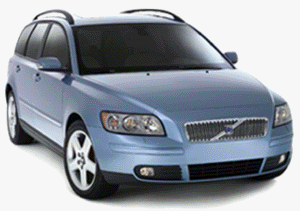 The Volvo V50 made its world debut at the Bologna motor show in Italy on 4 December 2003, and then was on show at the Detroit Auto Show, USA, in January 2004, before being seen for the first time in the UK at the NEC Boat, Caravan and Outdoor Leisure Show in February and then at The Sunday Times British Motor Show Live in May.
The Volvo V50 made its world debut at the Bologna motor show in Italy on 4 December 2003, and then was on show at the Detroit Auto Show, USA, in January 2004, before being seen for the first time in the UK at the NEC Boat, Caravan and Outdoor Leisure Show in February and then at The Sunday Times British Motor Show Live in May. 


